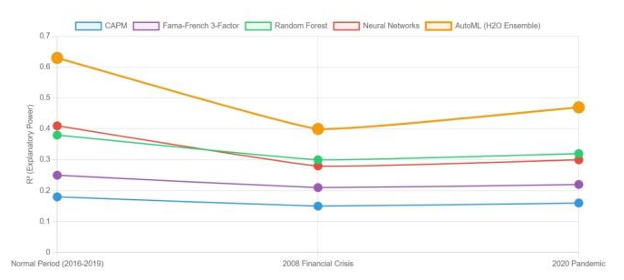Interpretable Automated Machine Learning for Asset Pricing in U.S. Capital Markets
DOI:
https://doi.org/10.70393/6a6574626d.333233ARK:
https://n2t.net/ark:/40704/JETBM.v2n5a03Disciplines:
FinanceSubjects:
Investment BankingReferences:
20Keywords:
Machine Learning, AutoML, Asset Pricing, U.S. Financial Markets, Risk Forecasting, InterpretabilityAbstract
Artificial Intelligence has become a fundamental driver of innovation in economic systems. Traditional asset pricing model face significant limitations in predictive accuracy, interpretability, and robustness under extreme market conditions. Although recent advances in Automated AutoML have improved forecasting performance, their “black-box” nature and fragility during crises limit their practical use in regulatory and policy contexts. This article provides an overview of its applications in stock trading, market analysis, and risk management. A systematic review of recent studies identifies the most widely used methods such as neural networks, deep learning, reinforcement learning, and hybrid approaches. This paper examines AI applications in economics, including stock trading, market analysis, and risk assessment. A comprehensive taxonomy is proposed to investigate AI applications in various scopes of the proposed categories. Furthermore, real-world cases illustrate the practical deployment of artificial intelligence in financial institutions and enterprises. The findings suggest that artificial intelligence is a transformative force in the economy but challenges such as data quality, transparency, and regulatory adaptation remain open for future research.
References
[1] Liu, Z. (2022, January 20–22). Stock volatility prediction using LightGBM based algorithm. In 2022 International Conference on Big Data, Information and Computer Network (BDICN) (pp. 283–286). IEEE.
[2] Pang, F. (2025). Animal Spirit, Financial Shock and Business Cycle. European Journal of Business, Economics & Management, 1(2), 15-24.
[3] Xiong, X., Zhang, X., Jiang, W., Liu, T., Liu, Y., & Liu, L. (2024). Lightweight dual-stream SAR-ATR framework based on an attention mechanism-guided heterogeneous graph network. IEEE Journal of Selected Topics in Applied Earth Observations and Remote Sensing, 1–22.
[4] Sun, Y., & Ortiz, J. (2024). An ai-based system utilizing iot-enabled ambient sensors and llms for complex activity tracking. arXiv preprint arXiv:2407.02606.
[5] Luo, M., Zhang, W., Song, T., Li, K., Zhu, H., Du, B., & Wen, H. (2021, January). Rebalancing expanding EV sharing systems with deep reinforcement learning. In Proceedings of the Twenty-Ninth International Conference on International Joint Conferences on Artificial Intelligence (pp. 1338-1344).
[6] Luo, M., Du, B., Zhang, W., Song, T., Li, K., Zhu, H., ... & Wen, H. (2023). Fleet rebalancing for expanding shared e-Mobility systems: A multi-agent deep reinforcement learning approach. IEEE Transactions on Intelligent Transportation Systems, 24(4), 3868-3881.
[7] Zhu, H., Luo, Y., Liu, Q., Fan, H., Song, T., Yu, C. W., & Du, B. (2019). Multistep flow prediction on car-sharing systems: A multi-graph convolutional neural network with attention mechanism. International Journal of Software Engineering and Knowledge Engineering, 29(11n12), 1727–1740.
[8] Zuo, Q., Tao, D., Qi, T., Xie, J., Zhou, Z., Tian, Z., & Mingyu, Y. (2025). Industrial Internet Robot Collaboration System and Edge Computing Optimization. arXiv preprint arXiv:2504.02492. 1
[9] Mao, Y., Tao, D., Zhang, S., Qi, T., & Li, K. (2025). Research and Design on Intelligent Recognition of Unordered Targets for Robots Based on Reinforcement Learning. arXiv preprint arXiv:2503.07340.
[10] Li, X., Cao, H., Zhang, Z., Hu, J., Jin, Y., & Zhao, Z. (2024). Artistic Neural Style Transfer Algorithms with Activation Smoothing. arXiv preprint arXiv:2411.08014. 3
[11] Pang, F. (2020, November). Research on Incentive Mechanism of Teamwork Based on Unfairness Aversion Preference Model. In 2020 2nd International Conference on Economic Management and Model Engineering (ICEMME) (pp. 944-948). IEEE.
[12] Wang J, Cao S, Tim K T, et al. A novel life-cycle analysis framework to assess the performances of tall buildings considering the climate change[J]. Engineering Structures, 2025, 323: 119258.
[13] Shih, K., Deng, Z., Chen, X., Zhang, Y., & Zhang, L. (2025, May). DST-GFN: A Dual-Stage Transformer Network with Gated Fusion for Pairwise User Preference Prediction in Dialogue Systems. In 2025 8th International Conference on Advanced Electronic Materials, Computers and Software Engineering (AEMCSE) (pp. 715-719). IEEE.
[14] Sun, Yuan, Navid Salami Pargoo, Peter Jin, and Jorge Ortiz. "Optimizing autonomous driving for safety: A human-centric approach with LLM-enhanced RLHF." In Companion of the 2024 on ACM International Joint Conference on Pervasive and Ubiquitous Computing, pp. 76-80. 2024.
[15] Yiyi Tao, Yiling Jia, Nan Wang, and Hongning Wang. (2019). The FacT: Taming Latent Factor Models for Explainability with Factorization Trees. In Proceedings of the 42nd International ACM SIGIR Conference on Research and Development in Information Retrieval (SIGIR'19). Association for Computing Machinery, New York, NY, USA, 295–304.
[16] Tao, Y., Wang, Z., Zhang, H., Wang, L., & Gu, J. (2025, July). Nevlp: Noise-robust framework for efficient vision-language pre-training. In International Conference on Intelligent Computing (pp. 74-85). Singapore: Springer Nature Singapore.
[17] Zhang, Z., Li, S., Zhang, Z., Liu, X., Jiang, H., Tang, X., ... & Jiang, M. (2025). IHEval: Evaluating language models on following the instruction hierarchy. arXiv preprint arXiv:2502.08745.
[18] Wang, H., Li, Q., & Liu, Y. (2024). Multi-response Regression for Block-missing Multi-modal Data without Imputation. Statistica Sinica, 34(2), 527.
[19] Tan, Z., Li, Z., Liu, T., Wang, H., Yun, H., Zeng, M., ... & Jiang, M. (2025). Aligning large language models with implicit preferences from user-generated content. arXiv preprint arXiv:2506.04463.
[20] Huang, T., Xu, Z., Yu, P., Yi, J., & Xu, X. (2025). A Hybrid Transformer Model for Fake News Detection: Leveraging Bayesian Optimization and Bidirectional Recurrent Unit. arXiv preprint arXiv:2502.09097.

Downloads
Published
How to Cite
Issue
Section
ARK
License
Copyright (c) 2025 The author retains copyright and grants the journal the right of first publication.

This work is licensed under a Creative Commons Attribution 4.0 International License.

















